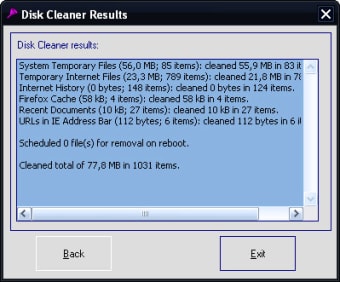

- #Window disk cleaner how to
- #Window disk cleaner install
- #Window disk cleaner driver
- #Window disk cleaner upgrade
- #Window disk cleaner windows 10
#Window disk cleaner upgrade
Previous Windows installation(s): When you upgrade to a new version of Windows, Windows keeps the old Windows system files around for 10 days.
#Window disk cleaner how to
RELATED: How to Free Over 10GB of Disk Space After Installing Windows 10's May 2019 Update You can remove these files if your PC and its devices seem to be working properly.
#Window disk cleaner driver
This option will delete those old device driver versions and keep only the most recent one.
#Window disk cleaner windows 10
Delivery Optimization Files: The “Windows Update Delivery Optimization Service” is the part of Windows 10 that uses your computer’s bandwidth to upload app and Windows updates to other computers.You can remove them to free up space, but then you’ll need to create and provide Windows installation media if you ever want to reset your PC. Windows ESD installation files: This one is important! As described above, these files are stored on your PC and used to “Reset your PC” to its factory default settings.System queued Windows Error Reporting: This is the same as “System archived Windows Error Reporting,” except it contains queued error reports that have not yet been sent to Microsoft.If you’re not attempting to solve a problem, they’re probably not important. You can choose to delete these, but you won’t be able to view reports about program crashes. Archived error reports have been sent to Microsoft. These error reports can help you identify and fix problems. System archived Windows Error Reporting: When a program crashes, Windows creates an error report and sends it to Microsoft.If you don’t plan on trying to troubleshoot any blue screens of death (or you’ve already fixed them), you can remove these files. However, these files can use a large amount of space. This file can help identify exactly what went wrong. System error memory dump files: When Windows crashes–known as a “ blue screen of death“–the system creates a memory dump file.Just remember: regularly erasing your browser cache slows down your web browsing. Other browsers like Google Chrome and Mozilla Firefox have their own browser caches you would need to clear from within Chrome or Firefox themselves. Note also that this only affects Microsoft’s browsers. You can clear this to free up space, but your browser cache will eventually fill up again. The cache includes bits and pieces of websites that are stored on your hard drive so you can load them faster in the future. Temporary Internet Files: This contains your “browser cache” for Internet Explorer and Microsoft Edge.They’ll be automatically downloaded again when you visit a website that requires them, if you need them. Downloaded Program Files: This folder contains ActiveX controls and Java applets that are downloaded from the Internet when you view certain web pages in Internet Explorer.If you don’t have any upgrade-related problems, feel free to delete these. These log files can “Help identify and troubleshoot problems that occur”. Windows upgrade log files: When you upgrade Windows–for example, upgrade from Windows 7 to 10, or upgrade from Windows 10’s November update to Windows 10’s Anniversary update–Windows creates log files.You can select this option to free up some space and Windows 10’s built-in antivirus will continue running normally. Microsoft doesn’t explain what these files are anywhere, but it’s likely they’re just temporary files. Windows Defender: This option deletes “non critical files used by Windows Defender“, according to the Disk Cleanup tool.

However, if you don’t plan on ever uninstalling any Windows updates, this is a waste of space. This is safe to delete as long as your computer is working properly and you don’t plan on uninstalling any updates. This allows you to uninstall the updates later.
#Window disk cleaner install


 0 kommentar(er)
0 kommentar(er)
